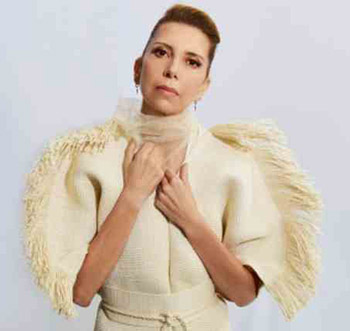by Peter Feher

It was an apt introduction to the artistry of the Mexico City-born jazz vocalist, whose boundary-free style can sometimes beguile and sometimes confuse.
Performing the wordless “Choro de Lua,” a track off her 2023 album Aire, Herrera sounded transcendent in certain moments but less than stellar in others. That pattern would continue throughout the evening in Gartner Auditorium — her set just beginning to coalesce near the end.
Herrera’s appeal as a singer has everything to do with her musical amorphousness. At her best, as in the catchy, up-tempo title song from Aire which she dispatched dexterously on Wednesday — she throws caution to the winds and gives herself over to the tune. In Aire, that meant tapping thoroughly into the groove and riding the rhythms of her backing trio: guitarist Vinicius Gomes, bassist Matt Penman, and drummer Alex Kautz.
But with other material, surrendering can be a matter of slowing down to savor the melody. This was wonderfully the case during “Cucurrucucú paloma,” a cherished 20th-century Mexican folk song that Herrera delivered in her signature breathy style. Whenever she wanted to access this soft, feathery sound, she had the sensitive support of her bandmates, particularly Kautz, who played the entire evening on brushes.
To balance that delicacy, Herrera can also deploy a big belt for emotional effect. This took center stage in “The Calling,” an original composition that saw her improvising less like a jazz singer and more like a muezzin, her voice crying out with raw, expressive power.
Herrera’s singing is well suited to extremes, so it was disappointing that so much of the rest of the set seemed to hem her in.
These strictures were especially noticeable in a series of arrangements that paired Herrera’s scatting with Gomes’ guitar playing, both performers doubling the same musical line. Songs that should have unfolded spontaneously were instead tightly scored, starting with the opening choro. Another original vocalese, “Papalote,” likewise kept the singer and guitarist locked in unison.
A setting of Argentine composer Carlos Aguirre’s “Milonga gris” offered an instructive difference, with Herrera able to break away on a couple of virtuosic scat solos that were unchecked by the pitches of an accompanying instrument.
Getting the audience involved was another questionable decision. Singing and clapping along certainly added to the energy of “Aire,” but these gestures began to seem like a crutch when they were reused in the Latin American standard “Alfonsina y el Mar” and Herrera’s own composition “Healer.”
The evening was just warming up when Herrera performed these final selections, and she bid farewell in musical style but with still so much left to be sung.
Published on ClevelandClassical.com December 31, 2024.
Click here for a printable copy of this article


